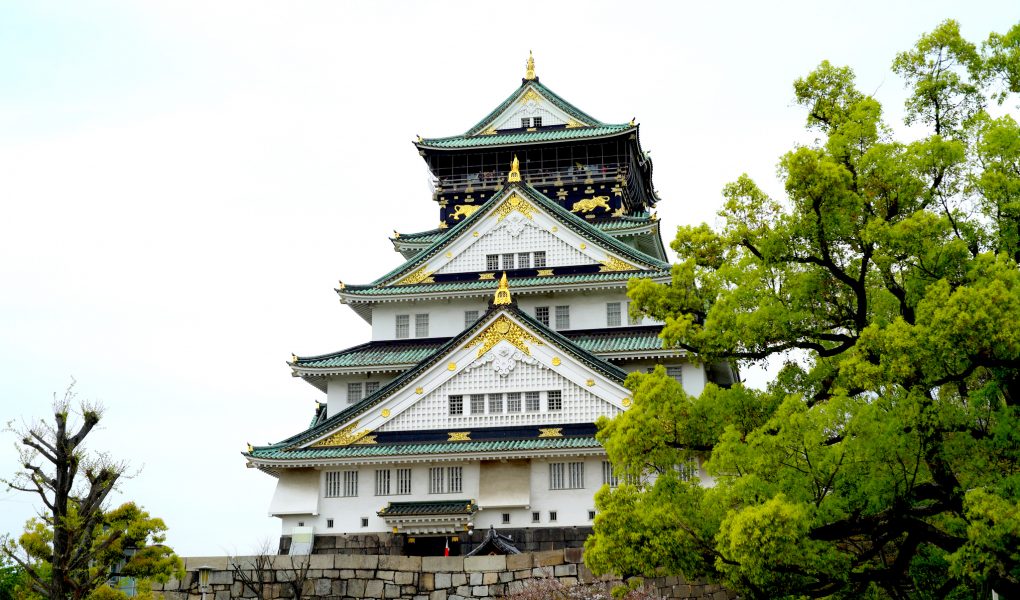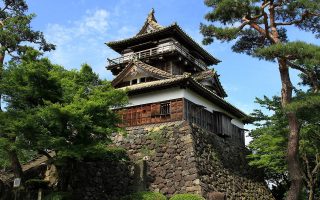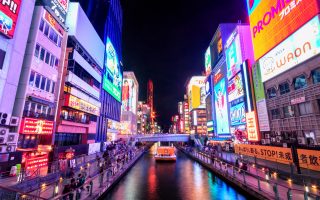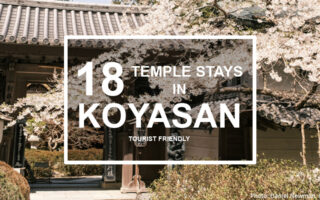Osaka Castle plays a central role in the history of the unified Japan. This beautiful castle is definitely worth a visit, both for it’s beauty, historic importance and scenic views.
Located in the center of the city, Osaka Castle is one of the major tourist attractions in Osaka. The beautiful castle, which was first founded in 1583 by Toyotomi Hideyoshi, has been the center of several conflicts during the unification of Japan. Osaka castle has a rich history and is a really important place in Japanese history. This makes it a fascinating place to visit. The castle is surrounded by a huge park area which attracts locals as well as tourists. During spring the 300 cherry trees which are planted around the castle park make the park the number one place for viewing cherry blossoms in Osaka.
The present castle is a reconstruction which was finished in 1997. The original castle was destroyed by weather and war over the years, and has been reconstructed on several occasions. Hence the castle seen today is made of concrete, and appears more like a museum once you enter the main structure (there is even an elevator). The external appearance however closely resembles the original. From the top floor there is a terrific view over Osaka.
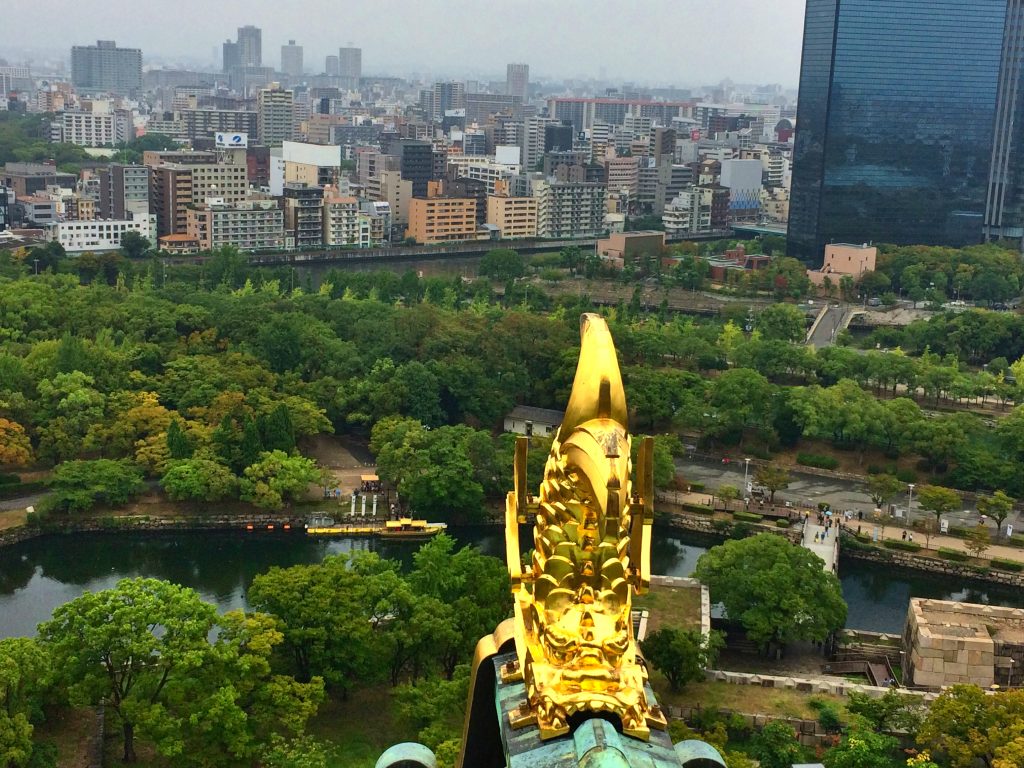
History of Osaka Castle
Before Osaka Castle
Osaka Castle is located on the former grounds of the Ishiyama Hongan-ji temple. Hongan-ji was the main temple and fortification of the Ikko-ikki sect, a buddhist sect of so-called warrior monks who were opposing the feudal lords (Daimyo) of the time. While Ikko-ikki generally had more character of smaller groups of rebellions, Hongan-ji was the sects’ biggest stronghold. In the late 1560’s Daimyo Oda Nobunaga was starting to take down opponents. He fought down many groups of the Ikko-ikki resistance, more or less finishing off the sect by taking down Hongan-ji. The temple was burned down in 1580, after a 10 year long campaign against the rebellions. Nobunaga’s campaign against the Ikko-ikki is also known as the Ishiyama Honhan-ji war, as it’s ultimate goal was taking down the Hongan-ji temple.
Construction of Osaka Castle
Nobunaga committed suicide in 1582 as a result of a coup against him. At the time of his death he had united a large part of Japan, and thus is known as the first of three unifiers of Japan. In 1583 Toyotomi Hideyoshi, the succeeder of Nobunaga, started the construction of Osaka Castle on the site of the Hongan-ji temple. Hideyoshi decided to model the castle after Azuchi castle which had been the headquarters of Nobunaga. He did however want to make the castle greater than Nobunaga’s in all aspects, so he constructed the main tower with 5 floors plus 3 underground floors, surpassing the 7-story Azuchi castle. Gold leaf was added to the outside of the structure to make it look even more impressive. What is truly the most impressive thing about Osaka Castle is the heavy fortification and double moat, which makes the premises appear impossible to invade.
Siege of Osaka
The siege of Osaka was a campaign taking place in two parts over a longer period between 1614 and 1615. Toyotomi Hideyoshi, who is considered the second uniter of Japan, died in 1598, leaving behind his 5 year old son Toyotomi Hideyori. Naturally too young to rule, a council of 5 elders was established to rule the united Japan until Hideyori had matured. Amongst those 5 were Tokugawa Ieyasu. A fight for power started in the group, eventually resulting in Tokugawa taking power and establishing the Tokugawa Shogunate in Edo in 1603.
The other elders being out of the picture, only Toyotomi in Osaka was in the way for Tokugawa. Tokugawa was afraid of Toyotomi rebelling against his shogunate, and so a campaign to siege Osaka was kicked off in 1614. The first attempt didn’t really succeed, but Toyotomi had to pledge not to rebel against the shogunate. Ieyasu filled the outer moat on this occasion, weakening the castles defence. In the summer of 1615, Toyotomi started restoring the castle’s outer moat. Rumors spread that Toyotomi was planning to rebel again. This resulted in Tokugawa (this time his son) attacking again and successfully defeating the rebellion. Toyotomi committed suicide when he realized it was over. This was the start of a unified Japan under the Tokugawa Shogunate and 250 years of peace.
During the Edo Period
The original Osaka Castle was burned to the ground following the siege of Osaka in 1615, but in 1620 reconstruction began. A new main keep was constructed. The new keep had 8 floors, of which only 5 were visible from the outside. New defensive walls were also constructed. These walls, which still stand today, are made of granite. Some of the granite blocks contain the names of the families who contributed.
In 1660 much of the castle burned due to a lightning strike in a building containing gunpowder. 5 years later, in 1665 another lightning strike hit the main tower, setting it on fire. The castle was neglected and not restored until almost 200 years later, in 1848. Twenty years later, in 1868 the castle was lost to imperial loyalists and much of it burned in the conflicts leading up to the Meiji Restoration.
After the Meiji Restoration
After the Meiji restoration Osaka Castle was converted to an Arsenal for the army. The arsenal remained active until 1945 when it was bombed and destroyed in the second world war. It was only in 1995 that the castle was restored, and in 1997 the doors opened to the new Osaka Castle. The main building is made of reinforced concrete and even features an elevator. From the outside the castle looks authentic though.
If you are interested in reading about more Japanese castles, then head over to the castles page.
Getting there
By JR Train: If you come from Osaka station or Tennoji Station, then take the JR Osaka Loop Line to either Morinomiya Station or Osakajokoen Station. The Osaka Loop Line is covered by the Japan Rail Pass.
By Subway: Get off at either Osaka Business Park (Nagahoritsurumiryokuchi Line) or Temmabachi (Tanimachi Line or Keihan Main Line).

